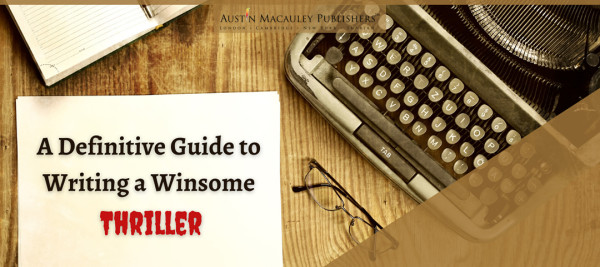
A Comprehensive Guide to Writing an Unputdownable Thriller
Thriller as a genre is growing in its popularity with every passing year. The origins of this genre can be traced back to centuries ago, with Homer’s Odyssey containing the basic elements of a thriller—suspense, anticipation, and even dread. In the second half of the twentieth century, thrillers got a boost when many well-known thriller novels made it to the cinema. Today, it is one of the most widely read and watched genre in the United States of America. According to the survey, ‘What types of books have you read in the past year?’ carried out by Statista, thriller, mystery, and crime topped the list with 47% of readers in the US in 2015. Compared to this, 27% read romance, 26% Sci-Fi, and 24% fantasy.
We, at Austin Macauley, publish books across a range of genres and have an amazing collection of thrillers.
But what is a thriller?
A thriller is a fast-moving story characterized by conflict, suspense, and tension encompassing many twists and turns. It keeps the readers on their toes, and every scene brings excitement, anticipation, and sometimes fear.
Notable examples include Gillian Flynn’s Gone Girl, Dennis Lehane’s Shutter Island, Stephen King’s Misery, Mario Puzo’s Godfather, most of them turned into movies. Similarly, when it comes to drama series, Breaking Bad and Money Heist top the list. Usually, crime and mystery go hand in hand with thriller, though there are key differences which should be kept in mind. Firstly, in crime and mystery, it is the protagonist that carries the story forward. While in a thriller, the story is taken forward by elements beyond the control of the lead character. Second, a mystery novel is usually about finding the culprit but in thrillers and crime, you may discover who the culprit is on the very first page. Having said this, crime, mystery, and thriller belong to the same family, usually complementing one another.
Now that you know what a thriller is, let’s answer the question of how to write a gripping thriller that will keep the readers hooked throughout. Stay here and keep reading. Below, we offer 6 tips for writing an engrossing thriller that will keep the readers on the edge of their seats. For a general guide, do not forget to read our how to become an author tips.
1. Creating Characters
The most important part of writing any story is the role of characters. Strong characters are crucial in writing in any genre, but in a thriller, it is absolutely essential to cast compelling characters. To be read or put down, this depends on how you design your characters. So, how to do that?
While writing a thriller, make the protagonist and antagonist multi-layered—not too perfect, not all too terrible. It is not necessary to have your good guy an ideal citizen, nor your bad guy a lost cause.
A flawed protagonist generates more suspense than an infallible one. The readers also relate more to one who is prone to errors. If you make him or her perfect, where is the excitement? For example, one of the criticisms of the Professor in Money Heist is that he is too perfect, having a thought-out plan for everything, however, the story takes a turn when he seemly lets love get in the way.
Similarly, the antagonist should have an understandable reason for behaving and playing wickedly. It could be anything such as a traumatic childhood, revenge for injustice—real or perceived, partner’s infidelity, incessant bullying, or domestic abuse, etc. In sequels to The Silence of the Lambs, we discover that Dr. Lecter witnessed the cold-blooded murder of his sister in his youth. Therefore, he is more than just a heartless serial killer—his evil actions stem from a heartbreaking trauma.
Last but not the least, when it comes to intelligence and wit, you must create a balance between both the protagonist and antagonist. They should be smart enough to outpace and outwit one another at one point or another.
If you have a story ready by your bedside and are looking to get it through the publishing phase, we are open to submissions.
2. Sprinkle Shocks in the Story
In our definition of thrillers, we discussed that thrillers are carried forward by the plot. Now, if it is a monotonous plot, readers will probably read some pages and swiftly put the book down. But if you have included the necessary shocks, turning points, and twists at definite intervals, the readers will want to know more. For instance, if your protagonist is a police officer, working on a case of murder. She is about to leave the office to pick up her daughter, getting distracted as she leaves by one of her colleagues. Meaning her daughter was not met at the school gate by her mother but rather someone that shouldn’t. Here the tension is created. The scenes in a thriller are written and portrayed such that the readers are compelled to say, “No, don’t go, don’t go there. That’s a trap,” “Hurry up! He is about to come,” “No! No! God, No!” etc. This is an example of shock. It is not necessary that the antagonist was here for the child. He may have been here to meet an old friend. Like this, pepper a few shocks across your story, especially at the end of every chapter. A shocking cliff-hanger at the end of a chapter keeps the readers wondering what to expect next.
3. Make it Clear What is at Stake
This is one of the most important elements of a successful thriller. While any story can generate suspense, excitement, and anticipation, what distinguishes thrillers from the rest is the stakes involved. Stakes are the consequences of a certain course of action if committed. They may vary – it may be the life of an individual, or the security of a whole nation. In Silence of the Lambs, at risk is the life of a girl—and if the antagonist succeeds, many other girls may become his victims. But in the Dark Knight trilogy, the future of a whole city, Gotham, is at stake. When you make the risks known, the readers align themselves more easily with the characters, putting their own stakes in the story.
4. An Engrossing Opening
A thriller doesn’t accept compromises on its opening. Take as much time as you want but have a gripping opening. Don’t settle for something that comes to your mind first. Explore alternative ways to open the novel, finally choosing the best one. It depends on your subgenre i.e. whether it is a psychological thriller, action thriller, or a crime thriller but it is better to open the story with an inciting incident where there is considerable action. There has been a string of murders where the serial killer needs to be found; a robbery is going to happen; a group has planned a terrorist attack and are on their way to execute their plans. These are just examples.
At this point, it is not necessary to describe characters, their story, and their motivations. Often aspiring authors make the mistake of describing the characters, compromising on the opening. You should avoid this.
We have made publishing your next thriller novel even easier. Fill our online submission form and let your work reach us for a detailed review.
5. A Well-Built Climax
The climax is the event your readers were waiting for. If they were on their toes, flipping one page after another, their goal was to reach to the climax—the moment of the final showdown between the antagonist and protagonist. It is here that the trajectory of the story is finalized.
Writing a well-built and meaningful climax requires dedication and effort, as it is a pivotal scene of the story. Gurus of thrillers suggest writing the climax first, before writing anything. This is because, when you write the climax first, the whole story is in front of you. This helps you stay focused throughout the process and you always know where your story is heading. Whether it is twists and turns, giving an edge to the antagonist or protagonist, you get enough room to build your story towards this moment.
6. A Satisfying Ending
And finally, a satisfying end. Unlike romance, a satisfying end doesn’t mean ‘a happily ever after’. But it must satisfy the readers when they finish their last sentence. Answer all the questions that were to be answered, wrap up all the action. We won’t reveal the endings of well-known novels for the fear of spoilers, but if you have read Gone Girl or The Silence of the Lambs, you would get what we mean by a satisfying end.
That said, thrillers do allow you to close the book with a cliff-hanger, only if you are planning to write a series. In that case, a shocking end may serve your purpose better than a satisfying one.
We hope these tips would be a stimulus for you to start working on your thriller novel. We wish you a successful journey in becoming a published author!
If, however, you have already created your masterpiece, let us help you get published. Send your manuscript at [email protected] or visit our submissions page to know more about the process.
Stay connected to Austin Macauley and be the first one to hear about our new releases. Join our social media handles and never miss another title. Follow us on Facebook, Twitter, YouTube, and Instagram.
We use cookies on this site to enhance your user experience and for marketing purposes.
By clicking any link on this page you are giving your consent for us to set cookies



